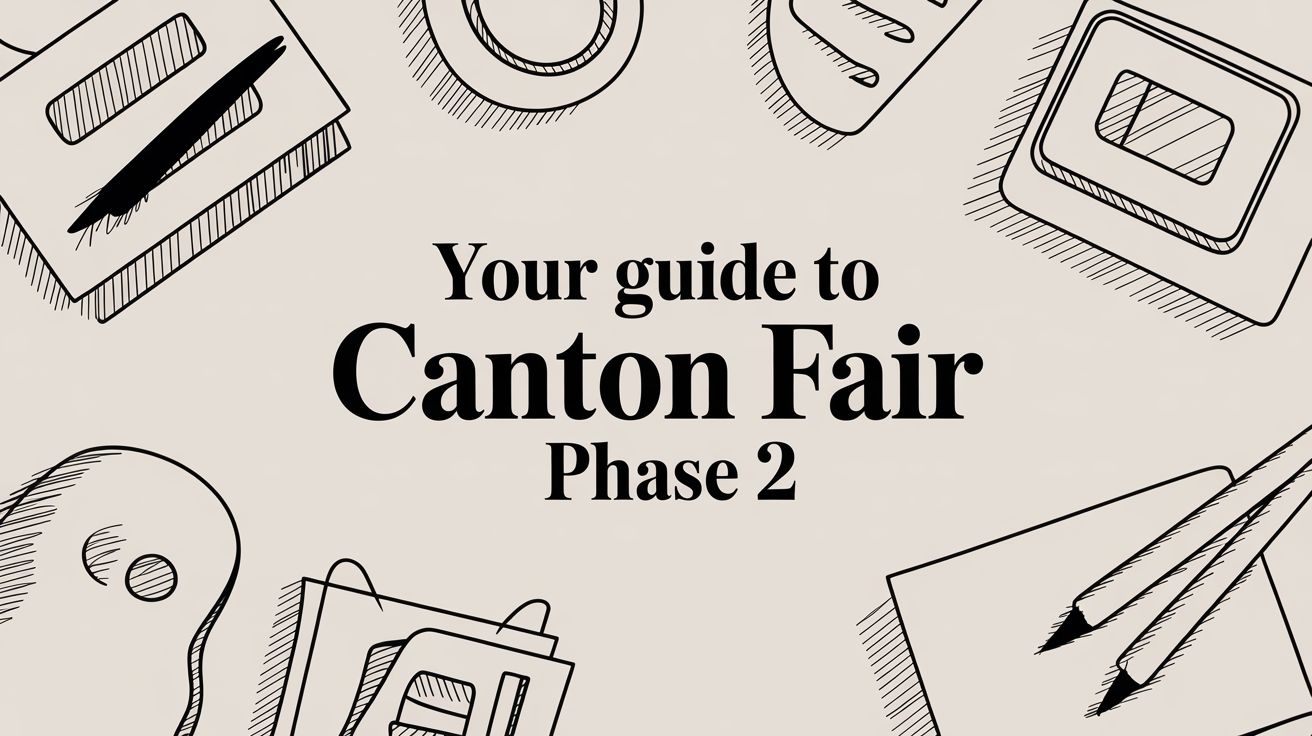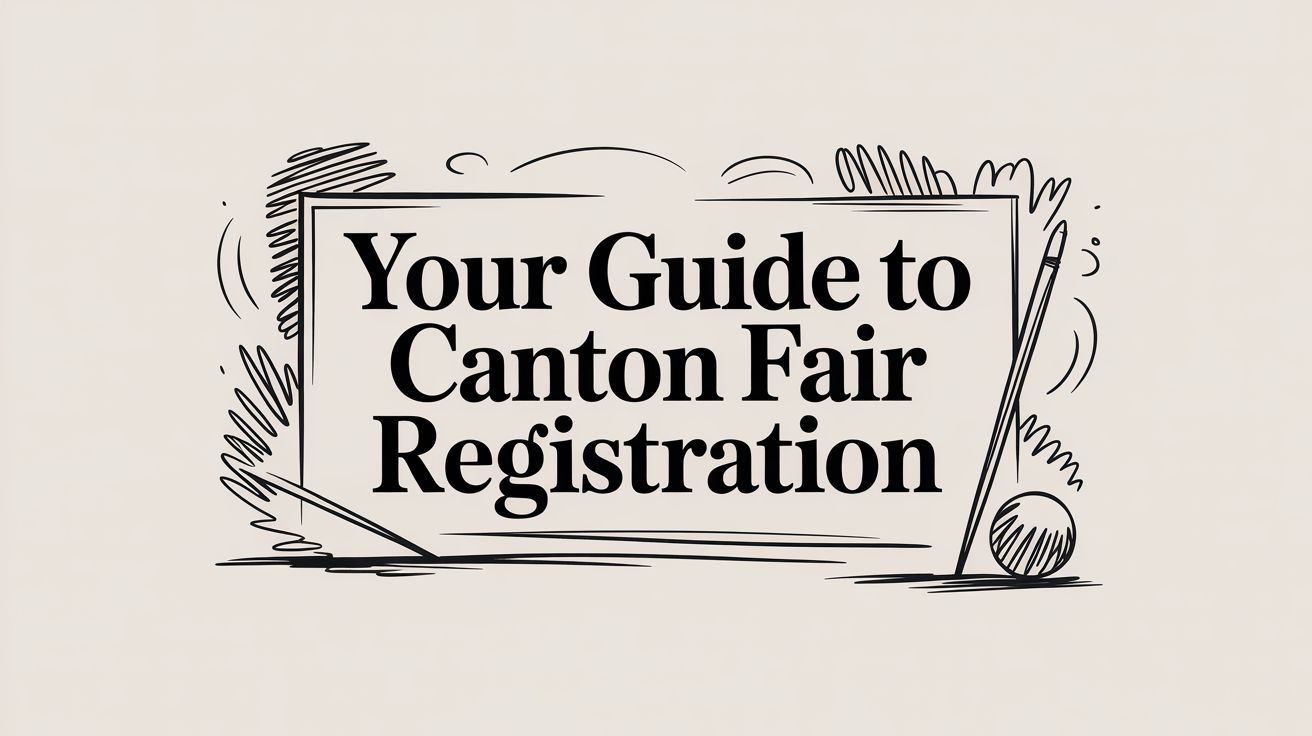Picture this: a sprawling, vibrant marketplace, but one that’s hyper-focused on lifestyle and consumer goods, all straight from Chinese manufacturers. That’s the essence of Canton Fair Phase 3. If the earlier phases are about industrial might, this final chapter is your direct line to the world of apparel, textiles, footwear, office supplies, medical goods, and even food products.
A Deep Dive into Canton Fair Phase 3
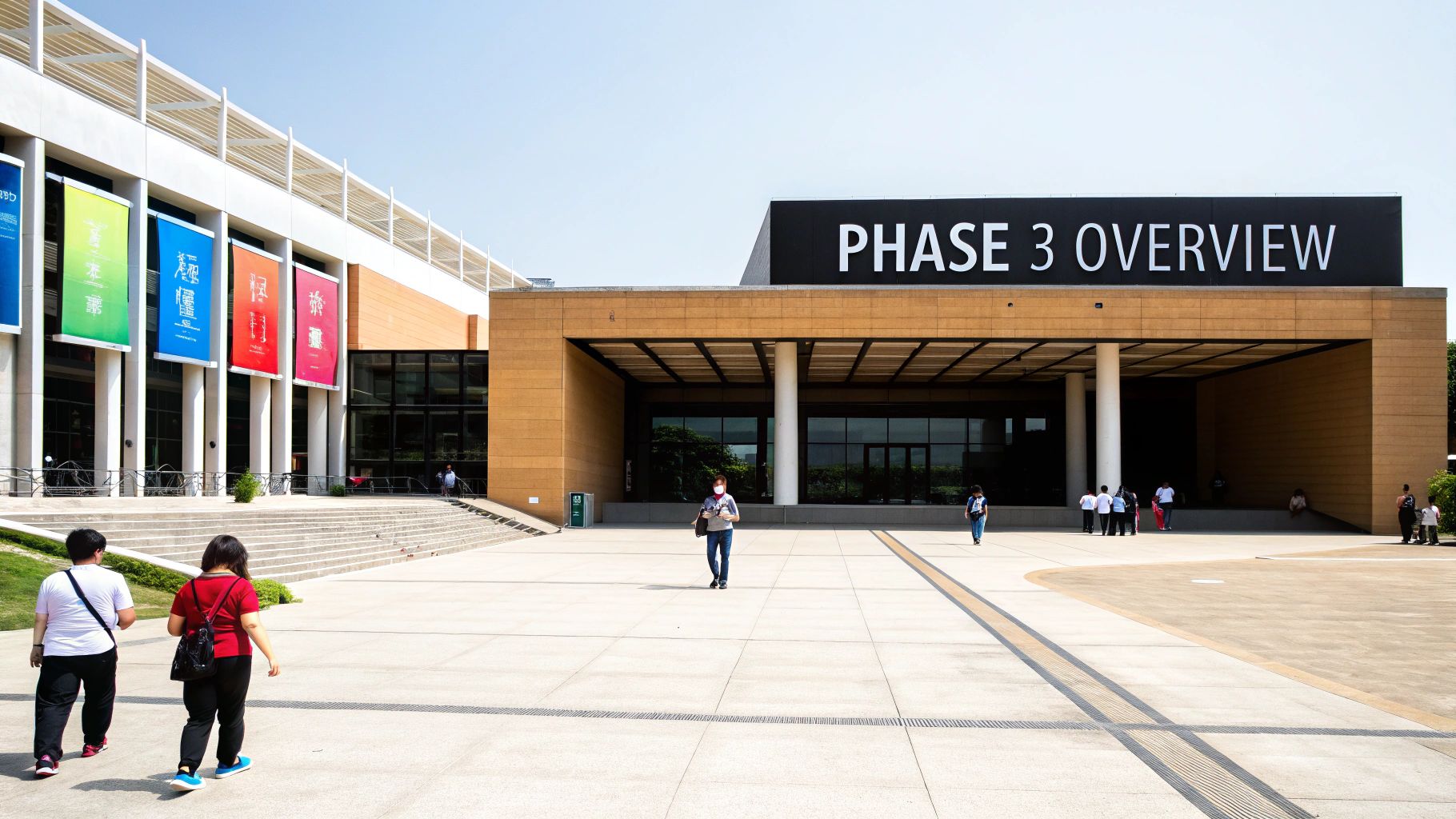
Phases 1 and 2 of the Canton Fair are a sea of heavy machinery, electronics, and construction materials. But when Phase 3 kicks off, the entire atmosphere shifts. This is where the focus turns to the products that fill our homes, offices, and retail stores. You could call it the "soft goods" and consumer lifestyle part of the show.
For anyone in the fashion, wellness, or consumer retail game, this phase is non-negotiable. It happens twice a year like clockwork—once in the spring (usually May 1-5) and again in the autumn (October 31 - November 4). This reliable schedule makes it easy for international buyers to plan their sourcing trips well in advance and connect directly with the right suppliers.
To give you a quick snapshot, here are the core details for Phase 3.
Canton Fair Phase 3 At a Glance
| Attribute | Details |
|---|---|
| Typical Spring Dates | May 1–5 |
| Typical Autumn Dates | October 31–November 4 |
| Primary Focus | Consumer goods, lifestyle products, and "soft goods" |
| Key Categories | Textiles, Apparel, Footwear, Office Supplies, Medical Products, Food |
| Location | Canton Fair Complex, Guangzhou, China |
| Best For | Retailers, brand owners, importers in fashion, wellness, and consumer sectors |
This table neatly sums up why Phase 3 is such a targeted and valuable event for specific industries.
What Defines the Phase 3 Experience
The vibe here is completely different from the other phases. Instead of the drone of machinery, you’ll find aisles buzzing with conversations about vibrant textiles, the latest fashion trends, and clever health products. It’s less about heavy-duty technical specs and more about aesthetics, material quality, and what consumers actually want to buy.
For an importer, this is gold. You get to physically touch the fabrics, try out product samples, and see new designs in person long before they hit the market.
The real magic of attending Canton Fair Phase 3 is the direct human interaction. It's your chance to build real relationships with suppliers, judge quality with your own hands, and negotiate terms face-to-face—something that’s nearly impossible to replicate over email or Zoom.
First launched back in 1957, the fair has grown into a titan of global trade. The event as a whole pulls in about 200,000 international buyers from over 223 countries and regions each year, making it the biggest trade show in China. This final phase alone attracts around 5,000 exhibitors, all showcasing their specialised goods. If you want to see how these numbers stack up against the other phases, you can find a full breakdown in this ultimate guide to Canton Fair phases.
Key Product Categories at a Glance
Knowing what's on offer is the first step to a productive trip. The sheer scale can be a lot to take in, but thankfully, the products are grouped into logical categories, which helps you stay focused.
Here’s a look at the main areas you'll find:
- Apparel and Textiles: This is a massive section covering everything from men's, women's, and kids' clothing to underwear, fashion accessories, and raw fabrics.
- Footwear, Bags, and Cases: An entire universe of shoes for every occasion, plus sports bags, luggage, and casual carry cases.
- Office Supplies and Stationery: All the essentials, from pens and paper to more sophisticated office equipment and organisational gadgets.
- Medical and Health Products: This popular category includes personal care items, medical devices, health supplements, and toiletries.
- Food and Pet Products: A rapidly expanding area featuring packaged foods, unique beverages, and a wide array of supplies for pets.
This tight focus is what makes Canton Fair Phase 3 such a powerful sourcing hub. You're not sifting through thousands of irrelevant booths. Instead, you’re dropped right into a concentrated ecosystem of manufacturers who make exactly what you're looking for, paving the way for a truly strategic and successful visit.
Finding Your Way Around: The Venue and Key Product Zones
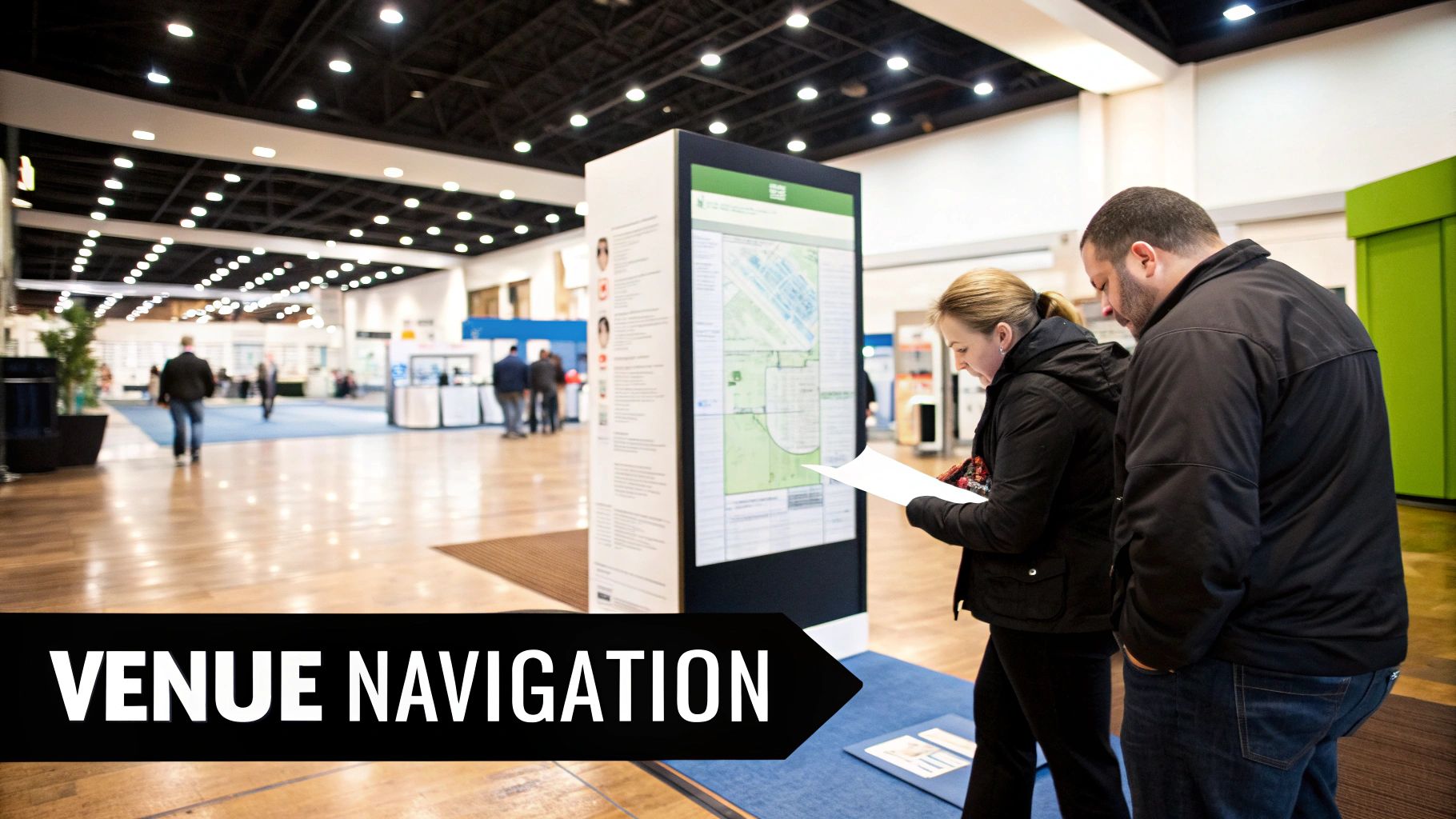
Walking into the Canton Fair for the first time without a plan is a classic rookie mistake. It's like trying to explore a massive, bustling city without a map—you'll get lost, tired, and probably miss the very things you came to see.
The sheer size of the Pazhou Complex is immense, but don't let that intimidate you. Its logical layout is your secret weapon, and with a bit of prep, you can navigate it like a pro. Think of this as your personal GPS for finding the right suppliers without wasting a single step.
Getting a Handle on the Venue Layout
The complex is divided into distinct areas, primarily Areas A, B, C, and D. During Canton Fair Phase 3, each of these areas transforms into a hub for specific consumer goods. This setup is designed to help you create a targeted plan, making every move you make a productive one.
For instance, Area A is the heart of all things fashion. Area B is your go-to for personal care, health products, food, and office supplies. Over in Area C, you'll find home textiles and raw materials. It's this specialisation that makes the fair manageable.
Knowing this layout before you arrive is non-negotiable. It allows you to map out an itinerary, grouping suppliers by area and saving you from backtracking across a venue that feels miles long.
Key Product Zones in Phase 3
To really dial in your visit, let's pinpoint where you’ll find the most popular product categories. Having a visual guide helps immensely, so be sure to check out our detailed Canton Fair map to see how these zones are organised.
Here’s a quick breakdown to help you find your targets:
- Fashion and Apparel (Area A): This is ground zero for anything wearable. Men's, women's, and kids' clothing, footwear, accessories—it's all here. If you're in retail, this is where you'll spend most of your time.
- Health, Wellness, and Lifestyle (Area B): This zone covers a wide range of daily consumer goods. You'll find suppliers for personal care items, health supplements, food, and even pet products. It’s diverse but all logically grouped together.
- Textiles and Soft Furnishings (Area C): Sourcing fabrics, raw materials, or home textiles like carpets and tapestries? Area C is your destination. This is where you can get hands-on and feel the quality of the materials.
- Bags, Cases, and Toys (Area D): This area is a treasure trove for cases, bags of all kinds, and a huge selection of toys, including products for babies and new mothers.
The Best Time to Visit
Just as crucial as knowing where to go is knowing when to go. The fair runs from 9:30 to 18:00 each day, but the vibe and crowd density change dramatically from one day to the next.
The middle days of the fair are the sweet spot. The initial Day 1 chaos has died down, and the final-day rush to pack up hasn't started yet. This is your prime window for focused, productive conversations with suppliers.
It's a tip passed down from one seasoned buyer to another: try to avoid the first and last days. The opening day is pure chaos with the biggest crowds. On the final day, you'll find many exhibitors are already mentally checked out and starting to pack up. Plan your key meetings for the second or third day, when everyone has settled in and is ready to do business.
Your Pre-Trip Preparation Checklist
Let's be honest: your success at Canton Fair Phase 3 is decided long before you ever step foot in Guangzhou. Think of your prep work as laying the foundation for a sourcing mission. Without that solid base, even the best intentions can crumble under the sheer scale and pressure of the event. Getting organised beforehand is what turns an overwhelming experience into a focused, productive, and profitable trip.
This checklist is your playbook. We're going to break down the monumental task of getting ready into a series of manageable steps, so you arrive confident and ready to do business from day one.
Secure Your Entry and Travel Essentials
First things first, let's get the non-negotiables out of the way. Leaving your travel and entry documents to the last minute is a recipe for stress and paying way more than you need to. The goal here is to have everything sorted at least one to two months before you fly, especially since flights and hotels book up incredibly fast.
Pre-Register for Your Buyer Badge: This is the most critical first step. Pre-registering online means you can pick up your official buyer badge with minimal fuss, completely bypassing the notoriously long queues that snake around the complex on the first day. For a clear walkthrough, check out our detailed guide on Canton Fair registration. It covers everything.
Apply for Your Chinese Visa: Unless you're from a visa-exempt country, you’ll need a business visa to enter China. Start this process early. It can easily take several weeks, and you don't want to be sweating it. You'll usually need an official invitation letter, which you can get from the Canton Fair's website once you've registered.
Book Flights and Accommodation: During the fair, Guangzhou becomes the epicentre of the global sourcing world. Book your flights and hotel well in advance to lock in reasonable prices and a decent location. A hotel near the Pazhou Complex or one with easy metro access will save you a massive amount of travel time each day.
And beyond the fair itself, a good guide on preparing for international travel can be a lifesaver for covering all the other essentials, from currency to health precautions.
Craft Your Sourcing Strategy
Walking onto that exhibition floor without a clear plan is like going to the supermarket hungry without a list—you’ll wander aimlessly, get distracted, and probably forget what you came for. A sharp, well-defined strategy ensures your time is spent where it counts: connecting with the right suppliers for the products you actually need.
A classic rookie mistake is trying to see everything. The fair is just too massive. A targeted approach, focusing on a pre-vetted list of exhibitors and specific product categories, will get you far better results than a scattered, "I'll know it when I see it" mindset.
Start by defining exactly what you’re looking for. Create a detailed "product one-pager" for each item you want to source. This should include:
- Detailed Product Specifications: Think materials, dimensions, colours, and any must-have certifications.
- Target Price Points: Know your ideal cost-per-unit and your absolute walk-away price.
- Minimum Order Quantities (MOQs): Define what’s actually feasible for your business.
- Packaging and Branding Requirements: Have your logo files and design concepts ready to show and discuss.
Before you go, use the official Canton Fair website to browse the exhibitor list for Canton Fair Phase 3. Shortlist suppliers that look promising, note their booth numbers, and map out their locations in the complex. This bit of homework is invaluable.
Pack for Business and Endurance
Your packing list needs to be a smart blend of professional gear and practical comforts. The days are incredibly long, the walking is relentless, and your energy is finite. Being prepared is what will keep you sharp.
Here’s a quick-fire list of what to bring:
- Business Cards: Bring more than you think you’ll need. I'm talking at least 200-300. You will hand them out like candy.
- Comfortable Shoes: This is absolutely non-negotiable. You will walk for miles every single day on hard concrete floors. Forget style; prioritise comfort.
- Portable Power Bank: Your phone is your camera, notebook, and translator. A reliable power bank is essential to staying connected and productive all day.
- A Professional Bag or Backpack: You'll be collecting catalogues, business cards, and small samples. You need something comfortable to carry it all.
- Your Sourcing Plan: Bring a printed or digital copy of your product specs and your shortlisted supplier list. Don't rely on memory.
By working through this checklist, you’re setting the stage for a great trip. You’ll arrive not as a tourist, but as a prepared buyer ready to make smart decisions and build valuable partnerships.
Mastering Negotiation and Supplier Vetting
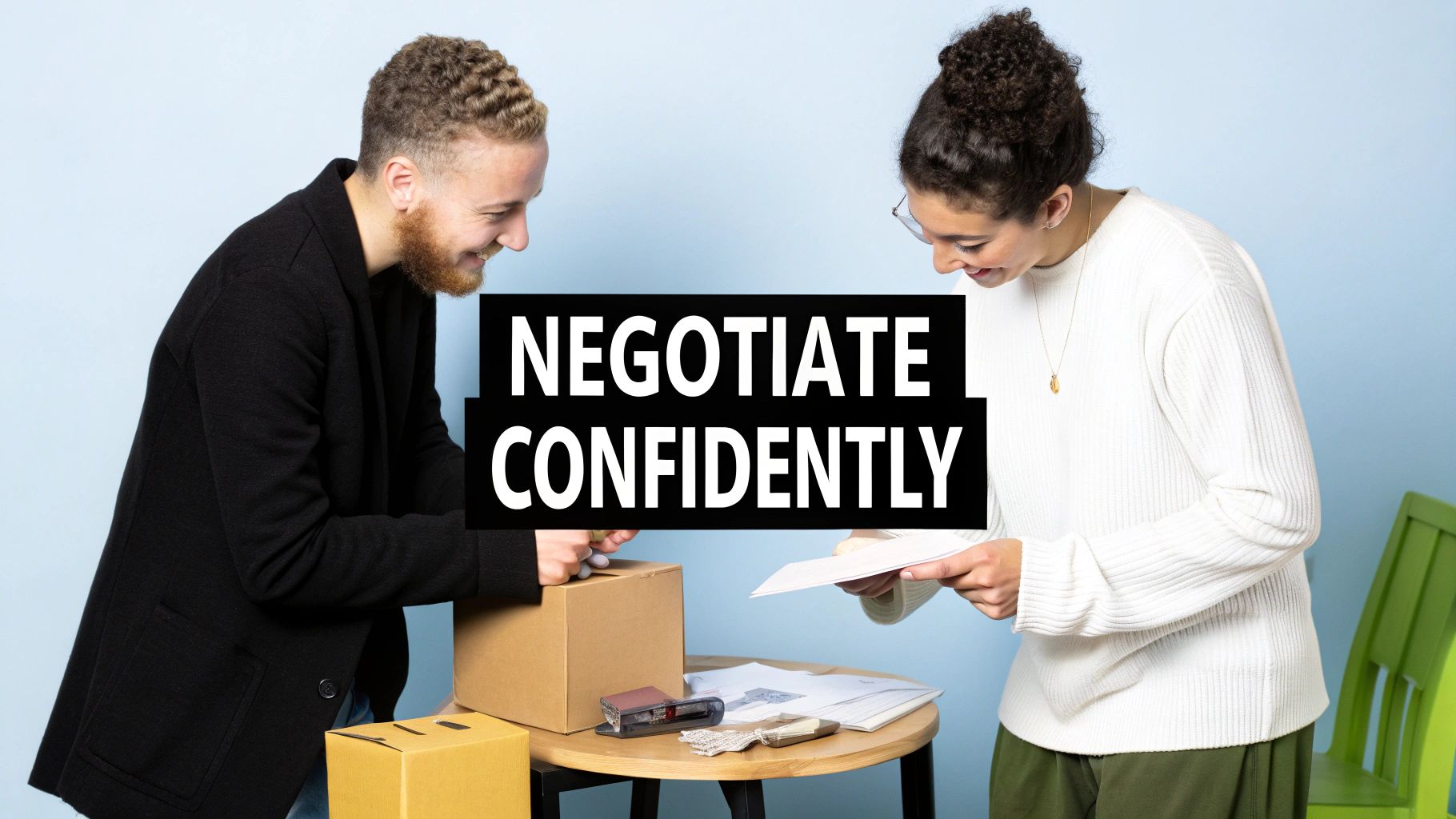
Alright, this is where the rubber meets the road. All your preparation leads to this moment: face-to-face with potential suppliers. Walking the massive halls of Canton Fair Phase 3 is one thing, but turning those brief encounters into solid, profitable partnerships? That takes a bit of finesse and some sharp vetting skills.
The atmosphere can feel like a whirlwind, but don't get swept up in it. Think of every conversation at a booth as more than just a quick chat. It’s your first real chance to see if a supplier is professional, what they’re capable of, and if they’re a good fit for a long-term business relationship. This is where you move from just looking to actually building.
Breaking the Ice and Getting Straight to Business
That first conversation really sets the stage. These suppliers are talking to hundreds, maybe thousands, of buyers. You need to stand out as a serious professional, and quickly. A polite greeting and a quick intro are great, but you need to pivot to your business needs fast.
Your best friend here is that product spec sheet you prepared. Instead of trying to vaguely describe what you want, you can hand them a clear document with materials, dimensions, and target costs. This immediately tells them you've done your homework. If you’re working with an interpreter, keep your sentences short and clear. Pause often. This gives them time to translate accurately and avoids confusion.
The best deals are struck when everyone's on the same page. Be direct about what you need, but don't shut down a supplier's suggestions. These guys are the manufacturing experts. They might have a brilliant idea for a material swap or production tweak that could seriously improve your product or cut costs.
This isn't about winning a battle; it's about starting a partnership. A collaborative tone will get you much further than an aggressive, one-sided demand.
Talking Money: Pricing and Payment Terms
Let's talk about the important part: the money. Don't be timid when it comes to pricing. The key term you'll hear over and over is Minimum Order Quantity (MOQ). This is simply the smallest order a factory will agree to produce.
But here’s a pro tip: the MOQ is almost always negotiable. If a supplier’s MOQ is 5,000 units but you only want to start with a trial order of 2,000, make that clear. Position it as the first step in what you hope will be a long and fruitful relationship. Most suppliers will bend the rules for a buyer who shows real future potential.
Payment terms are the other big piece of the puzzle. The standard deal you'll see is a Telegraphic Transfer (T/T), which usually breaks down like this:
- 30% Deposit: You pay this upfront so they can buy raw materials and get the production line moving.
- 70% Balance: This is due once the order is finished, usually just before it leaves the factory.
Nailing down these terms is crucial for managing your cash flow. Always get clarification on when that final 70% is due. Is it after you’ve had a chance to inspect the goods, or as soon as they say the job is done? The details really, really matter. If you're new to this, getting some expert help can be a game-changer. Our guide on sourcing agents in China dives deeper into how pros handle these details.
The Art of Vetting Your Suppliers
Finding a cheap price is easy. Finding a reliable partner who delivers quality goods on time, every time? That's the real challenge. This is why you have to vet every potential supplier you meet. You need to look past the shiny samples on the display table.
Your mission is to figure out how experienced they are, what their actual capacity is, and how serious they are about quality control. Don't be afraid to ask some pointed questions.
Supplier Vetting Checklist
To really understand who you're talking to, you need to ask the right questions. Here’s a quick checklist to help you get started on the spot.
| Question Category | Key Questions to Ask |
|---|---|
| Experience & Specialisation | "How many years have you been exporting to my country?" and "What percentage of your production is focused on this specific product type?" |
| Factory & Capacity | "Do you own the factory or are you a trading company?" and "What is your monthly production capacity for this item?" |
| Quality Control | "What quality control checks do you perform during and after production?" and "Do you have certifications like ISO or CE?" |
| Client & References | "Can you share examples of similar products you've made for other clients?" and "Do you work with any major brands in my market?" |
These questions aren't just for you to get information; they also test the supplier. A confident, transparent partner will have no problem answering them clearly.
If you want an even deeper layer of security, you might want to look into third-party product audit services that can give you an independent stamp of approval.
And one last thing: always, always get samples. Be specific about what you need and ask if they are free or if there’s a cost. A physical sample is your ultimate insurance policy. It ensures that what you hold in your hand is exactly what they're going to mass-produce for you.
You’ve found a fantastic product and negotiated a great price. It feels like you’ve won, but don't pop the champagne just yet. You're only halfway there. The real make-or-break details—packaging, labelling, and compliance—are next. Too many buyers get caught up in the excitement and gloss over these points, but tackling them right there at Canton Fair Phase 3 is what separates the pros from the amateurs.
Think of your product's journey from China as a rough-and-tumble adventure. The packaging is its suit of armour. Skimping on the box to save a few cents might seem smart at the booth, but it’s a disastrously short-sighted move that can lead to thousands of dollars in damaged goods and a wave of angry customers. This isn't a conversation for a follow-up email; it's a conversation to have, on the spot, with the supplier.
And it’s not just about protection. Your packaging is your brand's first handshake with the customer. This is your moment to talk customisation. Do you want your logo front and centre? Need specific brand colours? How about printed inserts with instructions or a thank-you note? A good supplier will be ready to walk you through these options, including how they affect the cost and production schedule.
Navigating International Product Standards
Once the packaging is squared away, you hit the next big hurdle: regulatory compliance. This is a minefield where importers, new and old, can get into serious trouble. Every country has its own rulebook for what’s allowed on its shelves, and pleading ignorance won’t get your container released from customs.
These aren't just polite suggestions—they're the law. If you’re importing electronics or toys into the EU, for instance, you can’t get by without the CE marking. Selling electronic gadgets in the US? You'll likely need to meet FCC standards. And for anything from food to cosmetics, you’ll be dealing with FDA requirements.
Let me be crystal clear: Never assume a supplier's product automatically meets your country’s legal standards. As the importer, the burden of proof is entirely on you. One mistake can result in your entire shipment being seized, massive fines, and a black mark on your business's reputation that's hard to erase.
This is a non-negotiable part of vetting any potential partner. Ask to see their certifications. A serious, experienced manufacturer will have this documentation organised and ready to show you. If they get shifty or vague, that’s a massive red flag. Walk away.
Your On-the-Spot Compliance Checklist
The specific rules you need to follow will depend entirely on your product. Sourcing t-shirts is a world away from importing face cream or children’s toys. To help you stay on track, use this checklist as a starting point for your discussions at the fair.
- Textiles and Apparel: Check for fabric composition labels and correct care instructions. For kids' clothing, ask about safety testing for things like drawstrings and small, detachable parts.
- Personal Care and Health Products: This is high-stakes. You must confirm ingredient lists, allergen warnings, and any necessary certifications like GMP (Good Manufacturing Practice).
- Food and Pet Products: Compliance here is incredibly strict. You need to verify everything from expiration date formatting and nutritional info labels to ensuring the packaging itself is certified food-grade.
- Toys and Children's Products: Safety is everything. Get confirmation that products meet standards like ASTM F963 (for the US) or EN 71 (for Europe), which cover hazards like lead paint and small parts that could be a choking risk.
Treating compliance as a central pillar of your sourcing strategy isn't optional. It’s how you protect your money, your brand, and most importantly, your customers. Getting this right at the fair will save you from a world of expensive, stress-inducing headaches later on.
Arranging Your Post-Fair Shipping and Logistics
You've done the hard yards at Canton Fair Phase 3. You've walked the aisles, met with suppliers, negotiated deals, and placed your orders. It feels like the race is won, but there’s one critical lap left: getting your products from the factory in China to your warehouse.
This is where your sourcing journey meets international logistics, and getting it right is non-negotiable. A misstep here can turn a profitable order into a logistical nightmare.
Think of it as the final leg of a relay. A clumsy handoff now could undo all your hard work. The two main ways to get your goods home are by air or by sea, and the best choice really hinges on what you value most: speed or cost.
Air Freight vs. Sea Freight: The Core Trade-Off
This is the classic logistics dilemma. There's no single "right" answer; it's about what makes the most sense for your business, your product, and your timeline.
- Air Freight: This is your express lane. Need to hit a tight seasonal deadline or restock a best-seller before you run out? Air freight is your answer. Just be prepared for the higher price tag that comes with that speed. It’s not usually the best fit for heavy, bulky items or products with thin profit margins.
- Sea Freight: This is the workhorse of global trade for a reason. It's by far the most cost-effective way to move goods, especially in large volumes. The catch? It's slow. A sea journey is measured in weeks, not days, so it demands solid planning and a good handle on your inventory management.
Before your goods can even be loaded, you need to be sure they meet the compliance standards for your target market.

This chart is a great reminder to check for things like CE marking for the EU or FCC certification for the US. Getting this sorted out before shipping will save you a world of headaches later.
Understanding Key Shipping Terms
As you start getting quotes, you'll hear a lot of new jargon. For sea freight, the two most important terms you need to get your head around are FCL and LCL.
- FCL (Full Container Load): This means you’re booking an entire shipping container (usually 20ft or 40ft) just for your products. It's generally more secure and can be a bit faster than sharing. If you have enough cargo to fill most of a container, it’s also the most cost-effective option.
- LCL (Less than Container Load): Don't have enough product to fill a whole container? No problem. With LCL, your shipment shares space with others. It's a fantastic, budget-friendly choice for smaller orders, though it can take a little longer because of the extra handling involved in consolidating and de-consolidating the cargo at each port.
We saw a lot of this at the 138th Canton Fair's Phase 3, where Chinese apparel and textile makers were showcasing some truly innovative designs. These kinds of high-value, trend-driven products often influence shipping decisions. The fair itself, held at the enormous Pazhou Complex at 382 Yuejiang Zhong Road in Guangzhou, keeps a predictable schedule, with Phase 3 running from May 1-5 in the spring and October 31-November 4 in the autumn. You can read more about these insights on China's apparel innovation to see how the industry is evolving.
Your Essential Customs Documentation Checklist
Getting your shipment through customs without a hitch comes down to one thing: paperwork. Meticulous, accurate paperwork. One missing signature or incorrect code can lead to costly delays, inspections, or in the worst-case scenario, your goods being seized.
Think of your customs paperwork as your shipment's passport. Without the right documents, it simply isn't going anywhere. Your freight forwarder is your expert travel agent, ensuring every form is filled out perfectly for a smooth border crossing.
While a good freight forwarder will handle the details, you need to know what to provide. These are the three non-negotiables:
- Commercial Invoice: The official bill of sale. It lists the buyer and seller, what the products are, their value, and the terms of the sale. Customs uses this document to calculate the duties and taxes you owe.
- Packing List: This is a detailed breakdown of exactly what's inside each box. It specifies the contents, dimensions, and weight of each carton, allowing customs to verify that the shipment matches the commercial invoice.
- Bill of Lading (B/L) or Air Waybill (AWB): This is the legal contract between you and the shipping company. It serves as both a receipt for your goods and the document of title—meaning whoever holds the original B/L can claim the cargo when it arrives.
Finding a reliable freight forwarder isn't a nice-to-have; it's a core part of your import strategy. They are the experts who will navigate the entire process for you—from booking space on a vessel to handling all the documentation and clearing customs—making sure the products you worked so hard to source at Canton Fair Phase 3 actually arrive at your door, safe and sound.
Got Questions About Phase 3? We've Got Answers
As you gear up for the final stretch of the Canton Fair, a few last-minute questions are bound to pop up. Here are some quick, practical answers to what buyers most often ask about Phase 3.
What Are the Official Dates?
One of the best things about the Canton Fair is its predictable schedule, which makes planning your trip a whole lot easier. You can reliably book your calendar around these dates.
- Spring Session: May 1st to May 5th
- Autumn Session: October 31st to November 4th
Can I Negotiate Minimum Order Quantities?
Yes, and you absolutely should. Think of the Minimum Order Quantity (MOQ) you see on display as a starting point for a conversation, not a hard rule.
Most suppliers are looking for long-term partners, not just a single sale. They're often willing to be flexible for a new customer with good potential. A great approach is to propose a smaller trial order to test the waters and build trust.
Negotiation is a two-way street. If you frame your request as the beginning of a strong business relationship, you're far more likely to get the flexibility you need.
Should I Pay for Orders at the Fair?
This is a big one: do not pay for large orders on-site. The fair is for discovery, negotiation, and handshakes—not for large financial transactions.
Use your time there to find the right partners, lock down product details, and agree on the terms. All payments, like an initial T/T deposit, should be handled once you're back home and have a formal Proforma Invoice (PI) from the supplier. This simple step adds a critical layer of security to your deal.

